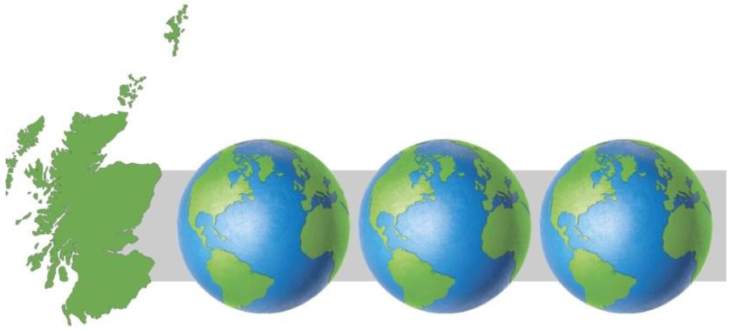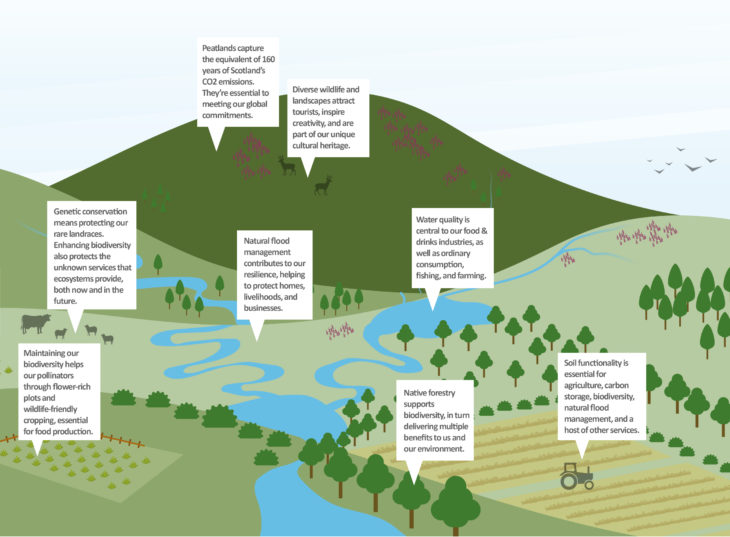Transitioning to Sustainable Agriculture
Where are we now?
The Intergovernmental Panel on Climate Change (IPCC) warns that in order to limit global warming to 1.5 degrees Celsius significant changes in the way land is used must be made.
Scotland’s food system is unsustainable. Soil nitrogen and phosphorus are already far-exceeding the planet’s limit; diffuse pollution from farm systems continues to be the main factor in water and soil quality; and a 2016 Scottish Government report showed “biodiversity loss had not yet been halted and would require renewed and sustained effort over a longer period”.
Some have pointed out that our agricultural emissions have declined since the 1990s. While that’s true, government data shows these declines “are often associated with reduced production rather than increased efficiency”, and agricultural systems continue to contribute over a quarter of Scotland’s emissions – the second largest contributor nationally. We haven’t made agriculture much more sustainable, we’ve just produced a little less and imported more. That doesn’t help mitigate climate change, it just exports the responsibility.
Meanwhile, the James Hutton Institute’s Greening Review identified that “farmland biodiversity has shown serious declines in habitat diversity and species numbers” owing to changes in land use, intensification, and pesticide use. But Scotland already has the means to start addressing these issues – and leaving the European Union must be the catalyst.
The most recent report by the Intergovernmental Panel on Climate Change (IPCC) warns that in order to limit global warming to 1.5 degrees Celsius significant changes in the way land is used must be made. The report also highlights the importance of reducing more than just carbon dioxide. Limiting global warming will require a 35% reduction in methane by 2050, relative to 2010, and significant reductions in nitrous oxide and black carbon.

Agriculture and related land uses account for 68% of methane and 79% of nitrous oxide emissions in Scotland – there’s no way to keep the planet on a sustainable footing without a major change in the way that our land is managed.
The ‘B’ word
Whatever route Brexit takes, the UK will be leaving the Common Agricultural Policy (CAP). For decades, the CAP has shaped our food and farming systems, even our landscapes and consumption patterns. It was designed to encourage the ever-increasing production of food in the post-war era, to make the most from a given area of land.
In the years since, even as our environment has suffered and our wider needs have changed dramatically, this base principle has remained. The CAP works by giving public money to produce food, with very few conditions attached to the majority of the funding. Many farms would be unviable without it.
This contributes to a market failure. The price we pay for food doesn’t reflect the true environmental and social costs of its production, packaging, transport, consumption, and waste. And it has the opposite effect, too: farmers are rarely rewarded for positive impacts, so there is little short-term incentive to move to a more sustainable model.
The Scottish Wildlife Trust has produced a fully-costed blueprint for such a system. Where issues like climate change, soil functionality, and biodiversity are systemically a part of how we produce food. This is detailed in our Land Stewardship Policy.
Public good
Change is already underway. A nationwide survey by ThoughtWorks in September 2018 suggests consumers are beginning to pay more attention to issues including plastic packaging, food waste, and where food comes from. Ethical considerations are moving up the list of consumer concerns.
The explosion of plant-based diets and the rise of zero-waste over the past few years shows how attitudes are changing, but as individual consumers we are limited. Our relationship to food is being affected by external pressures: income, climate change, waste, pollution, even how much time we have to cook. What’s required is systemic change.
Leaving the Common Agricultural Policy presents an opportunity to tackle the false choice between producing food and enhancing our wildlife and ecosystems. We can, and must, do both. In addition to areas that protect wildlife for its own sake, integrated land use means delivering ecological benefits while supporting agricultural processes, from minimising chemical use to boosting natural carbon storage, to joining up our disparate ecosystems.

The recently unveiled Agriculture Bill in Westminster is a big step in that direction. It’s not perfect, but it’s shown us that there’s appetite for public money to be used for public goods and public benefit.
But in Scotland we’re hesitating and delaying. The transitionary period for implementing a new agricultural solution is fast approaching and the government has yet to say what it is we’re transitioning to. Scotland can and should go even further than the Westminster Bill. Transitioning to an integrated system where public money is spent in the public benefit is the natural conclusion to years of government pledges to take environmental degradation seriously. We aren’t calling for any more than has already been promised. The EU is already moving in this direction, and organisations are calling for even greater traction: Scotland risks being left behind.
We need more than words
The Scottish Government has been big on ‘visions’ and ‘narratives’ and very limited on actual implementation. Over the past 10 years, it has favoured ‘guidance’- and ‘strategy’-type publications over actual legislation. This is most clear when comparing our Environmental Strategy with Wales’ Environment Act and Future Generations Act, commended by the UN.
For example, Scotland’s Land Use Strategy was ground-breaking, but land managers and agencies have been free to ignore it. This has resulted in an almost comical situation where much of the Trust’s recent policy work has been pressing for Scottish Government to pay attention to their own publications.
Many of these visions are progressive and welcome. It’s clear the Scottish Government has paid attention to the growing desire for change in Scotland. Unfortunately, it hasn’t responded in a way that’s a) commensurate with the scale of the problem or its urgency, or b) provides the appropriate, accountable legislative framework that requires policy outcomes rather than paying lip-service to them.
A good example is the Good Food Nation Bill. This measure enjoyed rare cross-party support and cross-sectoral support and promised to help address a host of urgent issues, from food provenance to childhood obesity. In the current Programme for Government, the Bill has been dropped to a ‘programme’ that has no legally enforceable status – resulting in complaints in Parliament from across the political spectrum, and dismay among the social and environmental groups who thought this particular battle had been won.
Scotland’s food system can be healthier, greener and higher value, and truly reflect the vision of a Good Food Nation. We need to value the country’s producers without just maintaining the status-quo. The choice is not about whether we change our food systems, change is inevitable. The point is to make sure this change is by design, not by disaster.
Scott Leatham, Policy Specialist
Help protect Scotland’s wildlife
Our work to save Scotland’s wildlife is made possible thanks to the generosity of our members and supporters.
Join today from just £3 a month to help protect the species you love.
Preface
Where are we now? The Intergovernmental Panel on Climate Change (IPCC) warns that in order to limit global warming to 1.5 degrees Celsius significant changes in the way land is …
